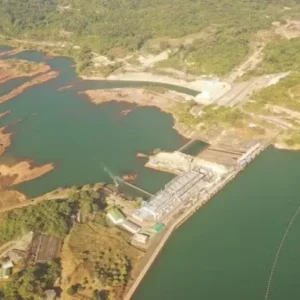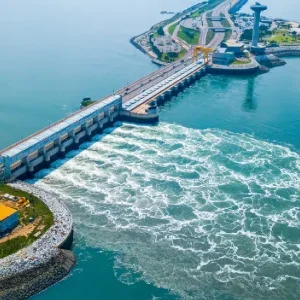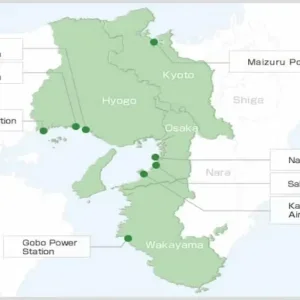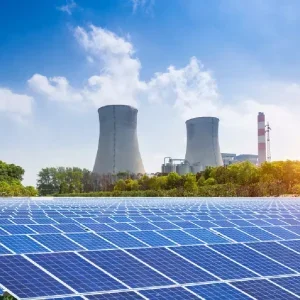THERE is no doubt that wind power is an established player in the energy generation market. And, although no offshore wave power devices have successfully been installed as yet, and it would seem that a marketable product is some way off, a handful of developers are attempting to achieve an equivalent conclusion for the emergent wave energy industry.
Integration of a wave energy conversion device into an existing electrical distribution grid requires an ability to convert an irregular power source into a regulated electrical flow. This has been the problem confronted and successfully overcome by wind power developers over the last half a century.
However, steady progress is being made towards the development of fully working wave power demonstration units, with several companies aspiring to have installations in place during 2004.
Academic institutes and universities have conducted a substantial level of the early work to develop wave energy converters. The outcome of these projects has resulted in several prototype devices being deployed with the most popular being the oscillating water column (OWC). In most cases, this device incorporates a single caisson that is located in a shoreline or mounted on the seabed. As the waves approach and flow into the structure, the motion of the water alternately pushes the air out of the enclosed chamber and then sucks it back in again as the wave recedes.
Conversion of the oscillating airflow into electrical power is achieved as the airflow is passed across a self-rectifying turbine. The incorporation of this type of turbine produces a single direction of rotation from the oscillating airflow, from which the generation of electrical power is possible.
The OWC operates by matching an enclosed mass of water to the characteristics of a specific wave type. At wave types over a small bandwidth either side of this design wave type, the OWC will operate at, or as close to, its maximum capacity. However, should incident waves have significantly different characteristics then the efficiency of the OWC will fall.
A variation of the fixed caisson OWC is the suspended cylinder OWC. Research has been conducted into the use of a suspended cylindrical column, open at its base, containing an enclosed air volume connected to a self-rectifying turbine. This configuration uses sub sea pressure fluctuations generated by the motion of the passing waves to force the water within the column to act as a piston. The configuration gives the device an omni-directional capture spread unlike the sea bed of a shore mounted caisson.
The suspended column is tuned to individual wave characteristics by altering the draught of the opening; simplistic tank tests can be conducted to show the resulting effect (see figure 1 overleaf).
The principle of the OWC has been used by a small team of researchers based at the University of Plymouth to develop the Multiple Oscillating Water Column (MOWC) concept. This device incorporates multiple columns ducted to vent and withdraw air through a single self-rectifying turbine and is being developed commercially by a university ‘spin out’ company ORECon Ltd (Offshore Renewable Energy Conversion) and a consortium of mechanical and electrical engineering companies.
Research commenced four years ago as part of a consortium funded by the European Commission and Department of Trade and Industry into marine renewable energy in the form of a wave energy device utilising the known potential of the OWC. By combining multiple oscillating columns within the collector component, it was possible to tune the device to resonate at multiple rather than single wave periods, thus capturing energy over a much broader waveband.
The confidence of the research team in the MOWC configuration stems from exhaustive research, calculations, simulations and above all successful sea trials. A scaled prototype that provided the data for the ORECon team was tethered in the approaches to Plymouth Sound in the UK, having a maximum draught of 12m, a displacement of 12.5 tonnes, incorporated three oscillating columns, a self-rectifying turbine and an electrical generator.
Success of the sea trials was carefully monitored by a sophisticated onboard monitoring system that was used to record the internal airflows, pressures and water surface elevations as well as the incident water surface profile.
The prototype was deployed in late February 2001 before being brought ashore for structural alterations during the calmer summer months and subsequently redeployed in early 2002 to catch the full extent of the winter storms. The sea trials of the 1/6th scale prototype generated an extensive amount of physical data; it also demonstrated the need to incorporate proven technology wherever possible.
Calculation of the conversion efficiency for the prototype has been conducted with an 18-day period being presented in this article. The method of analysis first calculated the power available to the prototype, as shown in figure 2, compared to the power generated across the self-rectifying turbine, a comparison of these two results then give an indication of the devices efficiency during the period.
Using the recorded data, showing the internal motions generated by the passing waves, the power extracted by the device was calculated (see figure 3). The results from the prototype sea trials showed that the multiple column approach presented an ability for a device to be tuned to generate power at low levels of input wave energy, while maintaining these levels during periods of increased wave activity. The conversion efficiency of the prototype during this period was calculated at 35%.
The evolutionary step that has been made by ORECon Ltd has ensured that its present concept not only possesses the ability to generate stable levels of electrical power over a wide range of wave characteristics, but it is done so by an elegant and robust structure.
As other developers have previously found, the optimum requirement has been for a device to be located offshore capable of surviving extreme seas, where it is less obtrusive to the local population, power levels are greater and capable of surviving extreme seas. The building cost of a sufficiently robust structure, and its obvious impact on supply prices, prompted some to focus on shoreline and nearshore devices in a compromise between structural integrity and output capacity. The ORECon solution combines the best of two distinctly conflicting industries. Firstly, by using known technology developed from the offshore oil and gas industry in a cost-effective spar configuration designed to withstand the harshest deep-sea environment for a minimum of 20 years. Secondly, by enhancing the collector system, which leading shoreline prototypes have shown to be the most successful wave energy converter to date.
A minimum depth requirement of 50m for the operation of a large-scale demonstration unit is required. Specification of this depth provides access to most of the available wave energy around the worlds coastlines, within 5-10km offshore, while limiting the cost of installing a large power transmission system and minimising intrusion on the local population and nearshore marine environment.
ORECon has now commenced the development of its large-scale 1MW demonstration unit. A device capable of generating this level of power will be in the region of 20m in diameter, 25m deep, having an air draught of 14m and an approximate displacement of 750 tonnes. It would be tuned to collect wave energy from a range of wave types depending upon the wave climate at each specific location. The device will be secured as a tension moored structure, to ensure maximum conversion capacity and limit the potential loadings that can be generated by the momentum of a structure this size.
Possible deployment sites are being studied which primarily include the Orkney Test site and north coast of Cornwall. Other locations being considered worldwide: Australia, New Zealand, South and North America, Canada and the Atlantic coast of Europe. Electrical infrastructure and physical surveys are being conducted to identify the most suitable location with regard to wave resource, environmental suitability, value of embedded generation and route to market.
ORECon is currently generating the technical engineering specifications for the large-scale demonstration unit within a consortium of marine related companies. Engineering consultants INBIS and mooring specialists Tension Technology International are assisting with the technical development of the concepts for design, build and power take off. Marine operations are being coordinated by AKA Maritime, who will also take over coordination of the survey operations for the chosen deployment location.
ORECon intends to have a 1MW demonstration unit in place during 2004, with the unit supplying the local distribution grid by 2005. The time to market is critical if ORECon is to meet our obligations to investors, however it must ensure that the device built is capable of surviving the hostilities of the marine environment, while maintaining a controlled generation of electrical power. Achieving the correct balance between these elements will be critical if wave energy is to fulfil its potential to become a dominant sector in the renewable energies market.
Related Articles
Pelamis construction completed






